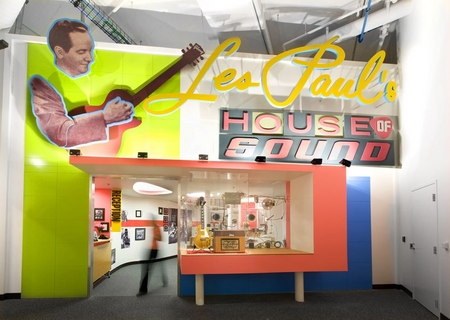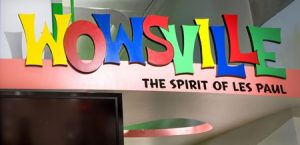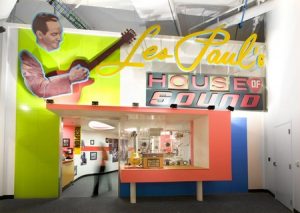For those under the age of 50, Les Paul is almost a mystical, yet largely unknown cultural figure, similar to revered pinstriper Von Dutch. Music aficionados know that he played a central role in the electric guitar’s evolution, but he’s often grossly underrated for his musical contributions.
However, Paul hasn’t been forgotten in his native Wisconsin. Milwaukee’s Discovery World hired Poblocki (West Allis, WI) to fabricate a 300-sq.-ft., mechanical sign, as well as several other complementary environment graphics for the exhibit, which will continue until the end of the year.
Major moments
Born Lester William Polfuss on June 9, 1915, in Waukesha, an outlying Milwaukee suburb, Paul began playing the harmonica at the age of eight. After beginning his professional musical career at age 17, he played with a variety of jazz and country ensembles. He played with Nat King Cole at the inaugural Jazz at the Los Angeles Philharmonic concert in 1944, and teamed with Bing Crosby, the Andrews Sisters and his wife, Mary Ford, to record numerous pop-chart hits.
Ultimately, however, Paul cemented his greatest musical legacy through experimentation. Seeking to improve upon the crude electric guitars available in the 1930s, Paul began experimenting with his own version. One of his more novel, and famous, attempts was “the Log,” which entailed a 4 x 4 fence post with a bridge, neck and pickup wedged into an Epiphone hollow-body guitar. The Gibson Guitar Co. used his template to develop the original Gibson Les Paul guitar, and he maintained a long-term relationship with the company.
Advertisement
Later, he pioneered multi-track recording. Initially, he etched acetate discs and layered multiple recordings onto the master. But, the development of magnetic tape and reel-to-reel playback exponentially broadened recording possibilities. Bing Crosby, seeing the potential performance and efficiency of reel-to-reel recording, subsidized the production of an Ampex Model 300, the first commercially produced reel-to-reel recorder, and gave one to Paul. Using this machine, Paul honed multi-track recording and such sound effects as echoes and flanging. These techniques enhanced the dozens of Top 40 recordings he and Ford produced.
In 1948, a car accident in Oklahoma nearly derailed his career. Doctors told him his severely broken arm couldn’t be reset to allow him to move his elbow. Faced with a lifetime with an immobilized right arm, Paul elected to have it set at a 90° angle that would allow him to hold and play a guitar.
Paul effectively retired from recording music in the late 1960s after he and Ford divorced, but he’s occasionally returned to the studio and earned two Grammys for his 2006 album, Les Paul and Friends: American Made World Played. He still plays every Monday night at the Iridium Jazz Club in NYC, even though arthritis has rendered three fingers on his left hand immobile.
Signs make the story
The Les Paul "House of Sound' exhibit, which begins in a recreation of his mother’s living room, whicht includes a player piano and crystal radio – two favorite items from Paul’s childhood – and flows through several scenes that depict important moments in his life.
Advertisement
Renee Bach, Discovery World’s creative/art director, said, “We want the visitor experience to reveal Les’ contribution as more than just the father of the electric guitar. He changed the way music is recorded and guitar-playing techniques.”
Bach served creative director and lead designer, worked with Eppstein Uhen Architects in laying out the main sign's design using CAD and Adobe's Illustrator and Photoshop. She said other museums had approached Paul about exhibits that chronicled his life, but he’d declined. “We created a highly interactive exhibit that emphasized his life experience and conveyed his musical innovations.”
Poblocki’s production of the main entry sign required a tight turnaround. According to Gordon Lindemann, Poblocki’s project manager, only 10 days elapsed from the initial meeting until the deadline.
Poblocki CNC routed the House of Sound logo from 15-lb. HDU; fashioned the guitar – a likeness of his namesake Gibson guitar — from machine-formed, .080-in. aluminum; and produced the head and arm from Celtec® composite material that’s decorated with 3M Controltac cast vinyl printed on a Mimaki JV3 solvent-ink printer. To create a continuous, strumming motion, fabricators implemented a Dayton 8.8 rpm, 1/8-HP motor that’s installed behind the wall and clandestinely connected to the arm.
To install the sign, Poblocki situated 1-in.-deep, aluminum standoffs and reinforced it with ½-in.-thick angle iron. Initially, Bach had designed Les Paul’s signature to be white, but, after it appeared washed out against the backdrop, Poblocki promptly applied yellow vinyl to create sufficient contrast.
Poblocki also fabricated complementary HDU signs with such Paul-inspired slogans as “Lester’s Mad Lab” and “Wowsville.” Bach designed the program with Googie-style typefaces and colors that infuse the graphics with the style from Paul’s heyday. Poblocki hand-cut these signs from HDU, painted them with acrylic-polyurethane paint and anchored them into drywall.
Advertisement


 Photo Gallery1 week ago
Photo Gallery1 week ago
 Ask Signs of the Times2 weeks ago
Ask Signs of the Times2 weeks ago
 Paula Fargo6 days ago
Paula Fargo6 days ago
 Real Deal3 days ago
Real Deal3 days ago
 Benchmarks2 weeks ago
Benchmarks2 weeks ago
 Photo Gallery6 days ago
Photo Gallery6 days ago
 Women in Signs2 weeks ago
Women in Signs2 weeks ago
 Women in Signs1 week ago
Women in Signs1 week ago

















